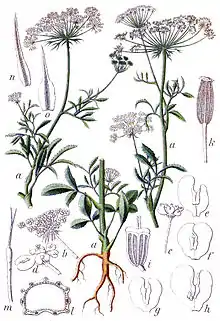Ammi (plant)
Ammi is a genus of about six species of summer-flowering plants in the carrot family Apiaceae. They are native to southern Europe, northern Africa and south-western Asia. They have fern-like leaves and white or cream coloured lace-like flowers borne in branched, rounded umbels.[1]
| Ammi | |
|---|---|
 | |
| Scientific classification | |
| Kingdom: | Plantae |
| Clade: | Tracheophytes |
| Clade: | Angiosperms |
| Clade: | Eudicots |
| Clade: | Asterids |
| Order: | Apiales |
| Family: | Apiaceae |
| Subfamily: | Apioideae |
| Tribe: | Apieae |
| Genus: | Ammi L. |
Ammi spp. (Bishops weed) is prohibited by the Australian New Zealand Food Standards code under standard 1.4.4 due to active constituents:
- furocromine
- coumarin derivatives
- .03% volatile oil (camphor and carvone)
- Fixed oil and protein
- flavonol glycosides (quercetin and kaempferol)
Ammi majus, A. visnaga and their cultivars are frequently seen in gardens where they are grown as annuals or biennials.[1]
Species
The following species are recognised in the genus Ammi:[2]
- Ammi huntii H.C.Watson
- Ammi majus L.
- Ammi trifoliatum (H.C. Watson) Trel.
References
- Brickell, Christopher, ed. (2008). The Royal Horticultural Society A-Z Encyclopedia of Garden Plants. United Kingdom: Dorling Kindersley. ISBN 9781405332965.
- "Ammi L. | Plants of the World Online | Kew Science". Plants of the World Online. Retrieved 2022-07-06.
This article is issued from Wikipedia. The text is licensed under Creative Commons - Attribution - Sharealike. Additional terms may apply for the media files.